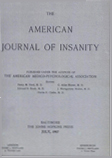CONVERSION HYSTERIA IN A CHILD
Abstract
The analysis covered a period of two months, during which the child was seen twelve times. As the patient had to return to school, further treatment was not feasible. At the present writing two years have elapsed since the patient was discharged from the analysis and she continues to remain well.
The procedure of this youngster's analysis was not like the analysis of an adult. It was much more rapid, and ran more smoothly. Most of the time she was sitting opposite me with her head turned sideways. For brief intervals she kept her eyes closed, as when first instructed. My own attitude toward her was friendly but distant. I made her feel that what she was telling me was not divulged, and for that reason when her mother or aunt tried to talk to me privately, I spoke loudly so that the child should not suspect that I betray her confidences.
As the analysis progressed she gained insight in the meaning of her illness. I pointed out her unconscious strivings in non-technical language, and gave explanations on sexual matters which she had known in a distorted way.
The analysis brought out the richness of phantasies of a sexual character and the masturbatory practices since the age of four. The incest strivings for father made themselves manifest in transference phenomena. Her continuous repetition that she will be an "old dame" expressed the hopelessness of ever obtaining father. Phantasy, however, came to aid when she could substitute father for images of him. The incest barrier thus removed she could frankly express her wish to marry her aunt's friends, her doctor-friend and later the analyst; all playing the unconscious role of father.
The birth phantasy was the dominating factor in the patient's symptomatology. This phantasy was reawakened at the time of her mother's pregnancy, when the patient was six and a half years old. The striking fact that the illness came on two days before the second birthday of her brother is shown by analysis to be no mere coincidence. The pains ("something going through and through") were those of parturition. She had ample opportunity to observe her mother just prior to labor, two years before. During the analysis she supplemented the original complaint by pain in the back, the explanation for which she herself supplied when she said that with that pain she was like her mother. Her posture while in an attack, as observed by Dr. Casamajor, simulated a woman in labor. This identification with mother aided in the fulfilment of her unconscious wish for father. The sudden withdrawal of her father's attention, which was keenly felt by the patient, created the need for the neurosis. The cause of this loss of affection was her rival brother, whom mother, the original rival, brought into the home of this previously only child. In her neurosis she proceeded to beget a child by father, then, when his ardent attention for her was suddenly withdrawn.
Thus, in psychoneuroses or psychoses, through somatic or psychic symptoms, unconscious strivings find expression by means of symbolism, identification, and other mechanisms common to the unconscious. In this manner reality is avoided, partly or entirely, when the individual is not adequately prepared to face reality.
Access content
To read the fulltext, please use one of the options below to sign in or purchase access.- Personal login
- Institutional Login
- Sign in via OpenAthens
- Register for access
-
Please login/register if you wish to pair your device and check access availability.
Not a subscriber?
PsychiatryOnline subscription options offer access to the DSM-5 library, books, journals, CME, and patient resources. This all-in-one virtual library provides psychiatrists and mental health professionals with key resources for diagnosis, treatment, research, and professional development.
Need more help? PsychiatryOnline Customer Service may be reached by emailing [email protected] or by calling 800-368-5777 (in the U.S.) or 703-907-7322 (outside the U.S.).



